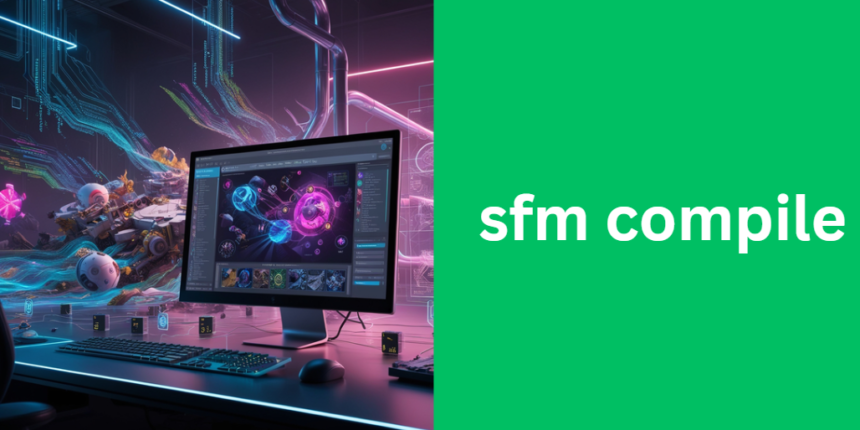Source Filmmaker (SFM) is a powerful tool created by Valve Corporation for producing animated movies and cinematic scenes using assets from the Source game engine. In this guide, we will explore the concept of sfm compile—a process that transforms 3D models, textures, animations, and other creative assets into formats that can be seamlessly used within SFM projects.
Understanding sfm compile is essential for any SFM artist or filmmaker. This process not only ensures that assets are optimized and integrated correctly but also enhances workflow efficiency and creative control. By mastering sfm compile, you benefit from improved performance, better project organization, and a smoother transition from asset creation to final output.
Below is a table summarizing the key benefits of mastering sfm compile:
| Benefit | Description |
|---|---|
| Enhanced Workflow Efficiency | Streamlines asset integration and project setup |
| Improved Asset Optimization | Reduces load times and enhances performance |
| Greater Creative Control | Allows for detailed customization and automation via scripting |
| Community Support | Access to extensive resources and forums dedicated to SFM projects |
Getting Started
System Requirements and Setup
Before diving into sfm compile, it is important to ensure that your system meets the necessary requirements. A properly set-up environment will save you time and reduce frustration later on. Your computer should at least have a dual-core CPU, 4 GB of RAM, and a DirectX 9 compatible graphics card. However, for an optimal experience, a quad-core processor, 8 GB or more RAM, and a DirectX 11 (or higher) graphics card are highly recommended.
The table below highlights the minimum and recommended specifications:
| Component | Minimum Requirement | Recommended Specification |
|---|---|---|
| CPU | Dual-core | Quad-core or higher |
| RAM | 4 GB | 8 GB or more |
| Graphics Card | DirectX 9 compatible | DirectX 11 or higher |
| Storage | 5 GB free | 10+ GB free |
Installing Source Filmmaker
Installing SFM is straightforward. Download the software from the official Source Filmmaker website or through the Steam platform. The installation process will guide you step-by-step. In case you encounter issues, online forums and official troubleshooting guides can be very helpful. Many beginners find it useful to watch tutorial videos which visually demonstrate the installation and initial configuration process.
Essential Tools and Software
To successfully execute sfm compile, you may need additional tools beyond SFM. Programs like Crowbar for model conversion and Blender for asset creation are invaluable. Setting up these tools properly is crucial, and you should follow installation guides provided by the developers. For example, after installing Crowbar, configure it to ensure smooth model decompilation and recompilation. Here is a list of essential tools to get started:
- Crowbar – for model conversion and error checking.
- Blender – for creating and editing 3D models.
- Texture Editing Software – for preparing and optimizing textures.
- Custom Scripting Tools – to automate repetitive tasks in SFM.
Understanding the sfm compile Workflow
The Compilation Process Overview
The sfm compile process is a systematic workflow that starts with asset creation and ends with final testing within SFM. At a high level, the process involves asset preparation, conversion of external files to SFM-compatible formats, integration of animations and textures, and iterative testing to ensure everything works as expected.
Data Pipeline: From Models to Final Output
When you create a 3D model or animation, it must be converted into a format that SFM can process. This conversion is handled by tools like Crowbar, which check for compatibility issues and ensure that the asset retains all its intended details. The data pipeline is critical: assets move from their original creation in modeling software to a compiled state where SFM can integrate them into scenes seamlessly.
Troubleshooting and Debugging Basics
Even with careful preparation, issues may arise during the sfm compile process. Basic troubleshooting involves checking error logs, verifying asset integrity, and ensuring that your tools are correctly configured. It is beneficial to develop a troubleshooting checklist that includes verifying file paths, confirming that all dependencies are installed, and ensuring that asset formats are supported by SFM.
Detailed Steps in the sfm compile Process
Asset Preparation
Asset preparation is the foundation of the sfm compile process. This step involves creating detailed 3D models, ensuring textures are high quality, and refining animations for export. It is recommended to maintain a consistent naming convention and organize your files logically, as this can significantly ease the later stages of the workflow.
For example, consider a scenario where you are preparing a character model. You would first create the model in Blender, apply textures with a dedicated editing program, and then export the animations. Keeping all these assets well-organized minimizes the risk of errors during the compile phase.
Converting Models with Crowbar and Other Tools
Crowbar plays a pivotal role in the sfm compile process by converting your models into the appropriate format. This involves decompiling models to check for any errors, making necessary corrections, and then recompiling them. A comparison of conversion tools shows that while Crowbar is popular for its robust features, alternative tools might offer unique advantages in certain scenarios. It is worthwhile to experiment with different options to find the best fit for your workflow.
Integrating Animations and Textures
Once models are converted, the next challenge is integrating animations and textures into SFM. Exporting animations correctly from your modeling software is critical, as any misalignment can lead to synchronization issues. Similarly, textures need to be imported with care to ensure that shaders and lighting work correctly in SFM. A successful integration leads to a seamless appearance of models and their animations within your final project.
Scripting and Automation in SFM
Automation through scripting is a game-changer for users who frequently perform repetitive tasks. By writing simple scripts, you can automate parts of the sfm compile process, such as asset renaming, error checking, and even batch processing of models. Scripting not only saves time but also minimizes the risk of human error, allowing you to focus more on creative aspects.
Compiling and Testing Your Assets
The final step in the sfm compile process is to compile and test your assets within SFM. After running the compile process, thoroughly test each asset to ensure it integrates smoothly and performs as expected. This stage is iterative—if issues are discovered, you may need to return to earlier steps for adjustments. Testing is a vital part of ensuring that the final output meets the desired standards.
Troubleshooting and Debugging sfm compile
Common Compilation Errors and Solutions
During the sfm compile process, you might encounter common errors such as missing textures, animation misalignments, or conversion failures. A practical approach to troubleshooting includes:
- Verifying that all asset files are present and correctly linked.
- Checking for updates or patches for your conversion tools.
- Consulting community forums for advice on specific errors.
Debugging Techniques and Tools
Utilize built-in logs and debugging tools within SFM and external utilities like Crowbar to identify issues. These tools provide error messages that guide you to the source of a problem. Keeping a debugging log can help track recurring issues and the solutions applied.
Community Forums and Resources
The SFM community is an invaluable resource for troubleshooting. Forums, Discord channels, and official Valve resources offer tips and solutions based on real-world experiences. Engaging with these communities not only provides assistance but also keeps you updated on best practices.
Real-World Examples and Case Studies in sfm compile
Step-by-Step Project Walkthrough
A comprehensive project walkthrough can illustrate the sfm compile process from start to finish. For instance, imagine a project where you create a short animated scene featuring a character in a dynamic environment. Document each step—from asset creation in Blender to the final integration in SFM—accompanied by screenshots and code snippets where necessary. This practical example reinforces the theoretical knowledge presented earlier.
Success Stories from the SFM Community
Numerous SFM artists have achieved success by mastering sfm compile. Their stories often highlight overcoming technical challenges, innovative techniques, and the creative breakthroughs that resulted. Reading these success stories can inspire new strategies and provide motivation for your own projects.
Comparative Analysis of Different Techniques
Analyzing different sfm compile techniques can help you understand the pros and cons of various methods. Consider a comparative table like the one below:
| Technique | Advantages | Limitations |
|---|---|---|
| Crowbar Conversion | Robust error checking, widely supported | May require additional tweaking |
| Alternative Conversion Tool | Faster processing, unique features | Less community support, limited tutorials |
This table helps highlight which approach might be best suited for your project needs.
Best Practices and Pro Tips for sfm compile
Workflow Optimization Strategies
To maximize efficiency, structure your project files and plan your workflow ahead of time. Consistent naming conventions and organized directories can prevent confusion and save time during the sfm compile process.
Maintaining and Updating Your Projects
Projects in SFM often evolve over time. Regularly updating and maintaining your files ensures that they remain compatible with new versions of SFM and third-party tools. It is beneficial to schedule periodic reviews of your assets and scripts.
Collaborative Development in SFM
For team projects, adopting collaborative development practices such as version control systems (e.g., Git) can significantly enhance productivity. Clear communication and shared documentation are key to a successful collaborative sfm compile workflow.
Future Trends in SFM and Asset Compilation
Emerging Trends in SFM
The world of SFM is continuously evolving, with new features and tools being introduced regularly. Keeping an eye on emerging trends can help you stay ahead. Innovations like improved real-time rendering and enhanced physics simulations are already shaping the future of SFM projects.
The Future of Asset Compilation
The future of asset compilation is likely to be influenced by automation and artificial intelligence. As tools become more sophisticated, the sfm compile process may become even more streamlined, allowing for near-instantaneous asset integration and error correction.
Staying Updated with Industry Developments
Regularly engaging with industry blogs, attending virtual conferences, and joining community forums are effective ways to remain informed about the latest developments. Continuous learning and adaptation are essential in an ever-changing creative landscape.
Conclusion
In summary, mastering sfm compile is essential for any SFM artist looking to elevate their projects. This guide has walked you through everything from the initial setup and asset preparation to advanced optimization techniques and troubleshooting strategies. By following the detailed steps and best practices outlined here, you are well-equipped to create high-quality SFM projects that stand out.
For your next steps, take the time to experiment with the techniques discussed, join community forums for ongoing support, and continuously refine your workflow. Embrace the learning process and share your experiences with others to contribute to the vibrant SFM community.
Frequently Asked Questions (FAQ)
What project management strategies can help me stay organized during sfm compile projects?
Using dedicated project management tools can make a significant difference when handling complex projects. While our article discussed asset organization and version control, you can also benefit from using platforms like Trello, Asana, or Notion to plan out tasks, assign deadlines, and track progress.
Creating detailed project boards, keeping a comprehensive asset inventory, and scheduling regular backups can help maintain order as your project scales.
Are there specialized communities or learning resources focused on innovative sfm compile techniques?
Yes, beyond the general SFM forums mentioned in the guide, there are niche online communities and channels dedicated to advanced sfm compile methods. Some Discord servers, specialized YouTube channels, and even online courses focus on cutting-edge practices such as custom scripting and unique asset integration techniques.
Engaging with these groups can provide insights into experimental approaches and help you stay at the forefront of evolving trends.
How can I future-proof my compiled assets against upcoming SFM updates or patches?
To ensure your assets remain compatible with future SFM changes, consider adopting a modular approach to asset creation. This means keeping your files and scripts as independent and standardized as possible.
Regularly monitoring official Valve updates and participating in beta testing for new SFM versions can also give you early insight into potential compatibility issues. Additionally, thorough documentation of your processes allows for easier updates and adjustments when needed.
What strategies help mitigate performance issues during large-scale sfm compile projects?
When handling a high volume of assets, performance optimization becomes critical. Beyond reducing polygon counts and optimizing textures, you might find it useful to break your project into smaller, manageable segments that can be compiled independently.
Implementing batch processing scripts and leveraging any available hardware acceleration can significantly decrease compile times. Periodic performance testing and proactive resource management will also help you address bottlenecks before they become problematic.
Can external plugins or third-party tools enhance my sfm compile workflow, and which ones should I consider?
Absolutely, integrating external tools can streamline many parts of the sfm compile process. While our article touched on essential tools like Crowbar and Blender, you might explore additional plugins that offer batch asset validation, automated error reporting, or enhanced debugging capabilities.
Many in the community have found success using tools that complement the standard SFM suite, so experimenting with a few and seeking recommendations in specialized forums can lead you to a more efficient workflow.
Other Posts Like sfm compile
canzone che ascoltavano in pulmino i interisti: Inter’s Bus Anthem Legacy
What PSI Radiator Cap for NSDD JD430 Yanmar Diesel: A Comprehensive Guide
Starbucks Gift Card Balance: How to Check, Reload & Use Your Card Efficiently











